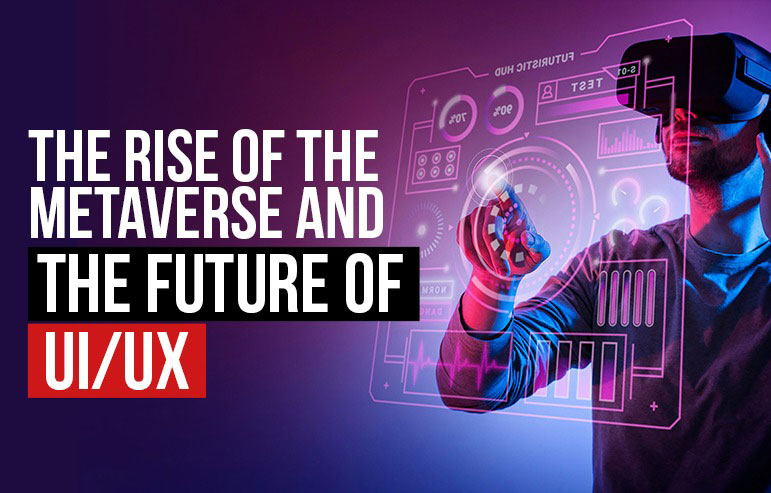UI/UX is the art of designing interfaces and experiences that make a user’s digital journey engaging and meaningful. UI and UX have become the cornerstone of humanistic design in the digital age. However, with the ever-increasing diversity of online platforms and the rapid evolution of operational and engagement models to meet user needs, the future of UI/UX design is changing dynamically.
The rise of the Metaverse is opening up a whole new world, where people see each other, interact, work and engage in a completely new way. It is a spectrum of virtual worlds and simulations where users are free to explore whatever they want – from building to coding and designing. With Facebook rebranding itself as Meta and more than 160 technology leaders working on the Metaverse, this platform will completely redefine advertising and interaction design in the next few years.
According to Precedence Research, the global Metaverse market is projected to grow to around USD 1,607.12 billion by 2030 and will be expanding at a compound annual growth rate (CAGR) of 50.74% from 2022 to 2030. One of the key factors to help Metaverse realise its true potential is a paradigm-changing user experience. As the Metaverse leaves the arcane realm of the world of technology and becomes mainstream, users will seek completely new interfaces and experiences as they get to know this new world better.
Globally there are more than 1.8 billion websites, 4 million mobile apps in use and 4 billion internet users. Undoubtedly, UI/UX designers already have many employment opportunities globally. The rise of the Metaverse will only expand that opportunity for talented designers. In the Metaverse, designers must develop realistic user interfaces and experience designs. They will need to understand how to create experiences that are fully immersive and believable and make new kinds of interactions based on how people will interact in the Metaverse. The immersiveness of the Metaverse will also demand that the designers understand the psychology of users and how they want their digital lives to be experienced.
Today’s users have countless online platforms where they can develop and share thoughts with millions of people. However, the Metaverse is still largely an alien world, with its own rules and essence, where one can think of anything and everything simultaneously. It is also a place where sheer creativity can open up endless possibilities which have never been experienced before. In time, the boundaries between this virtual world and the real world may overlap to create a whole new definition of the universe. Therefore, in the future, UI / UX design concepts will no longer be limited to virtual reality — they will also be applied to real-world applications.
So what does this rise of the Metaverse mean for designers? The Metaverse has opened up exciting opportunities for designers who wish to explore unique ways of projecting themselves into the future.
Designing for the Metaverse is a lot like creativity on any other platform. You still have to consider how your product will function in real life, whether it will appeal to users and make them want to buy it, and if it will be easy enough for people to use.
Right now, when designing for a virtual reality platform, there are no limitations on where one can go or who can interact with your product. In a Metaverse, however, designers are expected to develop realistic user interfaces and experience designs in a far more personal way. They will need to understand how to create experiences that are fully immersive and believable and foster new kinds of interactions based on how people will interact in the Metaverse. And they will need to understand the psychology of users and how they want their digital lives to be experienced. Designers eager to embrace the Metaverse will need to move towards cutting-edge technology and techniques such as 3D modelling alternatives like Tvori and SketchUp that will enhance modelling and prototyping in a 3D virtual world. Aspiring Metaverse designers must also not be scared of Artificial Intelligence (AI) replacing them. They should look to AI as a friend and a companion who will help them create better and more immersive designs built on a better understanding of user needs.
Although the opportunities are endless, the world of Metaverse does have some challenges for its designers in the present shape. There are some aspects that a future UI/UX designer needs to be aware of and careful about. Just like Blockchain, the decentralized and democratic setup can at once be a boon as well as a bane for Metaverse as well. Metaverse designers need to look out for themselves in case there is any litigation or dispute, since there is no one else who would be accountable for the design. As of now, governments and corporates are just beginning to get their arms around the immense possibilities of Metaverse, so there is a lack of regulations that can keep users and their data secure.
What is clear is that designers for Metaverse will need a good mix of technical skills and rich imagination, which can help them visualize various use cases and personas and use their designs to bring them to life. For example, a bank that uses Metaverse will require interactions that are quite different from a manufacturing company. The future designer for Metaverse will need to have an understanding of these different scenarios and have the necessary technical skills and knowledge to convert these scenarios to life.
Here are some of the learnings that are important for a Metaverse designer so that the UI and UX effective:
- Content in appropriate mode: The current consumer of digital content accesses it through computer screens, phone screens, music files, or movies. The user of Metaverse is likely to use augmented reality (AR) or virtual reality (VR) headsets to do the same. The Metaverse designer needs to be able to serve up existing content in a way that can be easily consumed by a Metaverse user.
- The right context: When we look at something in the physical world, the depth and perspective of the subject helps provide the correct context of the visuals. Metaverse designers will need to ensure that the mapping of the virtual objects is done in a way that seems lifelike.
- Privacy and security: The Metaverse as it stands now is a vast unknown, and there is a lack of regulatory authorities and adequate security measures to protect against identity theft, cyber bullying, or compromised credentials. Designers will have to integrate adequate lines of defence and provide users the options of how much they wish to share.
- Appropriate design tools: Creativity and imagination are the soul of a UX/UI designer for Metaverse, but the design tools are what would add muscle to the work she creates. There are a number of tools that will come in handy for translating ideas and layouts into usable scenarios.
- Width over depth: The Metaverse envisages the creation of alternate virtual worlds which can mimic the real world. This means that it is not enough to be able to design objects like offices, cars, shops, or even people. An understanding of a wide range of subjects would be needed, like sociology, economics, anthropology, politics and more, so that the scenarios and personas can be accurately designed.
Several courses are available that teach students how to design for the Metaverse. These courses start from the fundamentals of how to set up your workspace to fit Metaverse design project requirements—like having enough memory and RAM space—to acquiring design sensibilities and techniques for this new platform. So for designers who are unafraid to go beyond the known into the Metaverse, your learning starts now.
Disclaimer: The views expressed in the blog are personal and do not represent Chitkara University’s stand on the topic.






